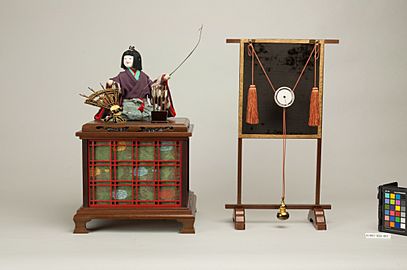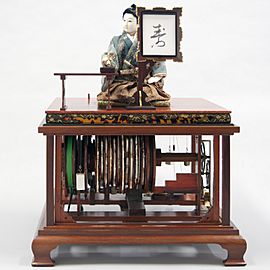Tanaka Hisashige facts for kids
Quick facts for kids
Tanaka Hisashige
|
|
|---|---|
 |
|
| Born | October 16, 1799 |
| Died | November 7, 1881 (aged 82) |
| Nationality | Japanese |
Hisashige Tanaka (田中 久重, October 16, 1799 – November 7, 1881) was a brilliant Japanese inventor and engineer. He lived during a time of big changes in Japan, known as the Bakumatsu and early Meiji period. Tanaka is often called the "Thomas Edison of Japan" or "Karakuri Giemon" because of his many amazing inventions. In 1875, he started a company that later grew into the famous Toshiba Corporation.
Contents
The Life of Hisashige Tanaka
Hisashige Tanaka was born on October 16, 1799, in Kurume, Japan. His father was a craftsman who worked with tortoise shells. From a young age, Hisashige showed a special talent for making things.
Early Inventions and Clever Ideas
When he was just eight years old, Tanaka invented a clever inkstone case. It had a secret lock that only opened if you twisted a cord in a special way. By the time he was 14, he had created a loom. This machine could weave very detailed and beautiful patterns into fabric.
Master of Karakuri Puppets
When Tanaka was 20, he started making karakuri puppets. These were amazing mechanical dolls that could move on their own. They used springs, air, and water to make them work. These puppets were very popular with important people in Japan, like the aristocrats and powerful lords.
At 21, he traveled around the country, showing off his clockwork dolls at festivals. He decided not to take over his family's business. Instead, he let his younger brother do it so he could focus completely on his karakuri puppets. Two of his most famous karakuri puppets are the Yumi-Hiki Doji (arrow-shooting boy) and the Moji-kaki doll (letter-writing doll).
New Challenges and Discoveries
In his mid-thirties, Tanaka wanted to invent things that were more useful for everyday life. In 1834, he moved to Osaka. There, he experimented with how air and water could be used to power things. He also worked on new ways to make light using rapeseed oil. He invented a small pocket candlestick and an oil lamp that used air pressure to pump fuel. These inventions became very popular.
Later, he moved to Kyoto. Here, he studied rangaku, which was the Japanese way of learning about Western science and technology. He also studied astronomy. He invented a fire pump that used air pressure. In 1851, he built a special clock called a myriad year clock. This clock was so amazing that the Japanese government has named it an Important Cultural Property.
Building Japan's First Steam Machines
As Japan started to open up to the world, Tanaka's skills became even more important. He was invited to Saga Domain in Kyūshū. There, he designed and built Japan's very first steam locomotive and a steam warship. He had never built these before, but he learned from a Dutch book and by watching a steam engine demonstration by a Russian diplomat in Nagasaki in 1853.
He later studied at the Nagasaki Naval Training Center. After it closed, Tanaka returned to Saga. He worked at a place called Seirenkata. Here, he built models of steam warships and a steam locomotive. He also experimented with making a telegraph and even a glass factory. He helped build a special furnace in Saga to make modern cannons. In 1864, he went back to his hometown of Kurume Domain to help develop new weapons.
Founding Toshiba
In 1873, when Tanaka was 74 years old, he was still full of energy. The Japanese government invited him to Tokyo to make telegraphs. He moved to the Ginza district in 1875. He rented a space in a temple in what is now Roppongi to set up his workshop. This workshop grew into his first company, Tanaka Seisakusho (Tanaka Engineering Works). It was the first company in Japan to make telegraph equipment.
Hisashige Tanaka passed away in 1881. After his death, his son continued the company. It changed its name to Shibaura Engineering Works (芝浦製造所, Shibaura Seizōsho) in 1904. In 1939, this company merged with another one called Tokyo Denki. Together, they became Tokyo Shibaura Denki, which is known today as Toshiba.
Images for kids





